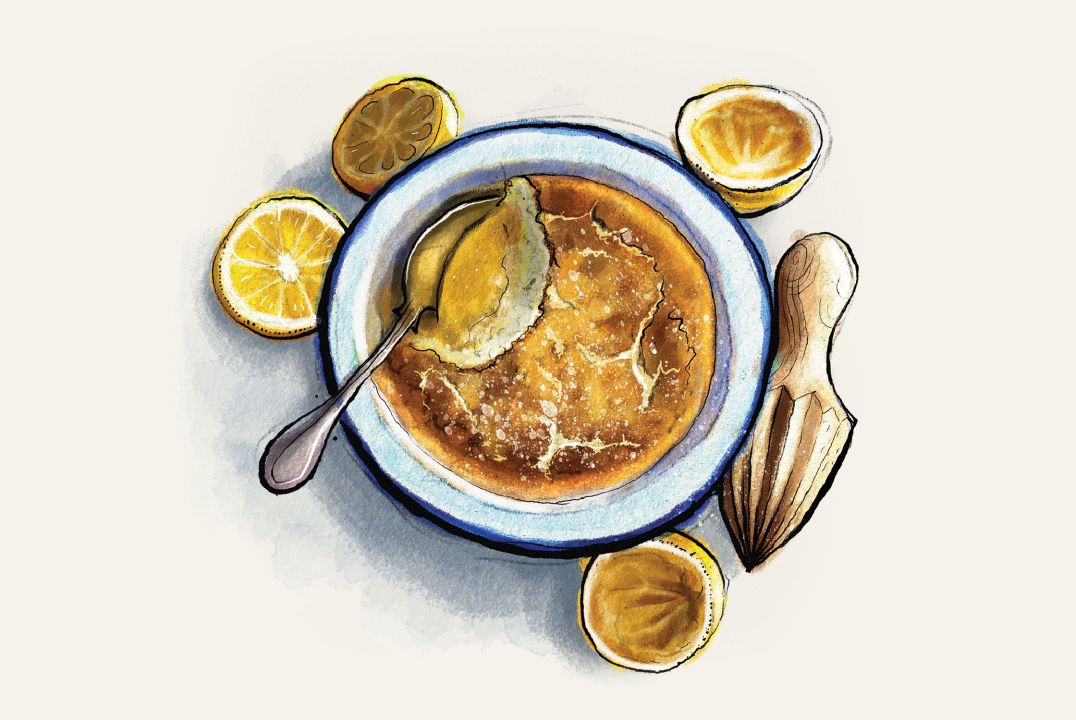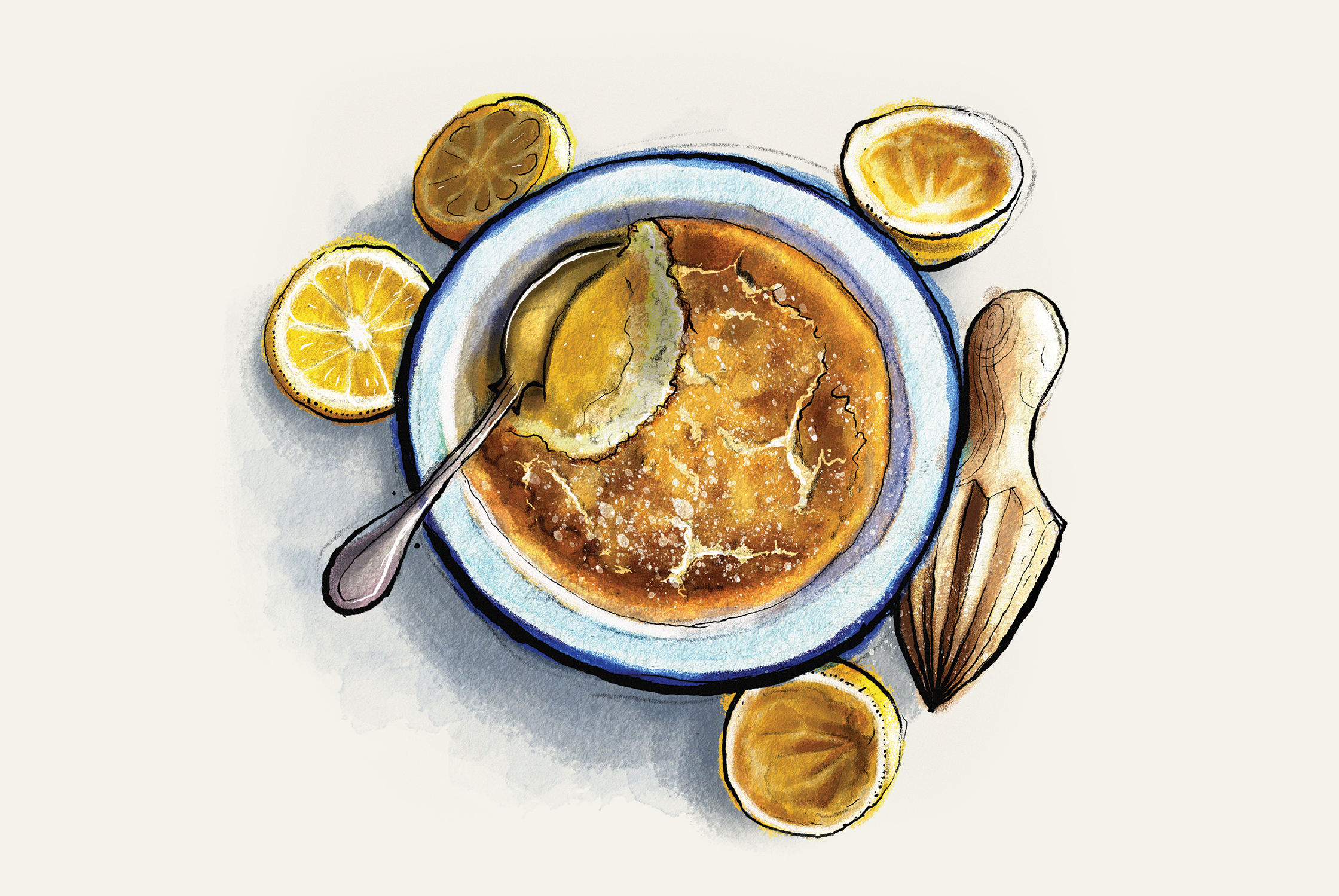
January kitchens are my favourite. This isn’t anything against Christmas – I love the spice, the frenzy, the ritual of festive cooking, but I also love the aftermath. There’s something calming about the kitchen once it’s all over – nothing is made through obligation, or with a deadline. I embrace the cosiness of autumn and the sparkle of Christmas, but I find the bright, cool light of January reviving and renewing. At this time of year my kitchen is a place to take stock and make stock. To steady and sustain.
Proper puddings, hot and sweet and served with cream, are a non-negotiable part of late winter
It’s also full of puddings, among other things. Proper puddings, hot and sweet and served with cream, are a non-negotiable part of late winter for me. And a lemon self-saucing pudding, baked in the oven, is certainly a proper pudding. It may not have the most elegant of names, but it does tell you what’s going on: a self-saucing pudding – also more lyrically called a ‘lemon delight’ or a ‘lemon surprise’ – is one where a batter is made, but during the process of baking it separates out into a sponge layer and a sauce underneath.
The exact make-up of the dish varies: some are more soufflé than pudding, some vice versa, and the corresponding sauce comes in every texture, from thin cream to a soggy bottom. There are wildly varying ratios of milk to flour, and this is what determines the texture of the sponge and the sauce. The recipe here, I think, is the Goldilocks version: the sponge is light but robust while the sauce is rich and spoonable – and crucially it doesn’t feel like the batter has just accidentally split.
To make the pudding, you start just as with a sponge, creaming butter and sugar together before adding egg yolks, flour and a surprisingly large amount of milk and lemon juice. The mix is then lightened by folding in stiffly whisked egg whites. The whole thing is then piled into a baking tin and cooked in a bain marie in the oven, ensuring gentle and consistent heat. As the dish cooks, the mixture puffs up and tautens on the surface, but beneath it separates out, forming two distinctive layers, one a souffléd sponge, light and tender, and beneath it a luscious lemon curd-like sauce.
When you first dip a serving spoon into the dish and reveal the sauce, it does feel a little like magic – and like all magic, it requires some faith. There’s no way to see what’s happening below the surface of the pudding, so you just have to hope and trust that beneath the golden exterior, under the soft sponge, there is a luscious layer of bright, lemony curd (but don’t worry, there will be – it’s magic).
Of course, there are variations on a theme: Seville orange in place of some or all of the lemon is a particularly lovely (and seasonal) one, or a slosh of elderflower cordial further through the year; passion fruit is as tart and sunny as the classic lemon; or you can go darker and bolder with a version using blackcurrants. But I like to start my year with lemons, as it feels like an optimistic way to welcome it in.
The usual lemon commandments apply: there should be no half measures. I want the full lemon zip, the slight bitterness from the zest, and that perfect sharp-sweet balance. This has the possibility of turning out to be a mellow, lemon-scented pudding, but that’s not what we are after at all. I want it to sing a four-part harmony of sweet, bitter, floral and tart. So there are a full three lemons’ worth of zest and juice here, with the zest beaten into the sugar to release those beautiful aromatic oils.
Like all the best puddings, it should be served with thick, cold pouring cream. I can’t tell you how I know this, but I can also confirm that any leftovers are also surprisingly excellent straight from the fridge the following morning.
Serves 4
- Takes 15 mins
- Bakes 40 mins
- 100g butter
- 3 lemons
- 200g caster sugar
- 3 eggs, separated
- 50g self-raising flour
- 250ml milk
- Preheat the oven to 180°C/160°C fan, and grease a large baking dish with a little butter. Boil a full kettle of water.
- Zest the three lemons, and cream together the butter and sugar with the zest. Add the egg yolks one by one.
- Alternate adding the flour and the milk, each in three lots. When this is done, add the lemon juice.
- Whisk the egg whites into stiff peaks. Take a large spoon of this egg white and add it to the rest of the mixture, mixing very thoroughly. Then fold the rest of the egg white gently through the mixture in three loads.
- Pour the mixture into the baking dish, and place the baking dish in a larger roasting tin. Fill the roasting tin halfway up with boiling water, and bake for 40 minutes. Allow it to stand for five minutes, and then serve.








Comments